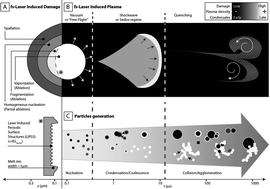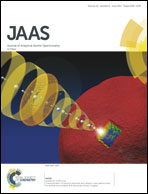Femtosecond laser ablation inductively coupled plasma source mass spectrometry for elemental and isotopic analysis: are ultrafast lasers worthwhile?
Abstract
Laser ablation inductively coupled plasma mass spectrometry (LA-ICP-MS) is a well-established technique for elemental and isotopic analyses. However, one of its major developments involving ultrafast lasers delivering pulse widths of tens to a few hundred femtoseconds has yet to fully emerge, fifteen years after its introduction. The lack of a widespread use of femtosecond (fs) lasers in LA-ICP-MS analysis appears surprising since this technology nearly eliminates several of the drawbacks of using nanosecond (ns) lasers: (1) at appropriate fluences, fs laser ablation is nearly athermal; (2) it ablates materials irrespective of their optical properties and (3) it produces particles with a modal distribution close to ∼0.1–0.2 micrometres, easily decomposed in the ICP torch. These properties result in significantly reduced chemical fractionation, a process through which evolving compositions are detected relative to that of the target sample. Hence, the use of fs lasers alleviates the need for matrix-matched calibration for elemental concentration and isotope ratio analyses. This is a decisive advantage for natural materials, often chemically complex and heterogeneous. It is indeed difficult to manufacture or find in nature equivalent homogeneous solids for calibration purposes using ns LA-ICP-MS. Easy ablation of optically transparent materials makes analysis much easier using a fs laser. Furthermore, the ablation yield is higher in the fs regime than in the ns regime, thereby increasing the sensitivity of the LA-ICP-MS technique. However, strategies have been developed to obtain reliable data using ns LA-ICP-MS. This makes the advanced properties of the more expensive and, until recently, more complicated to operate fs laser ablation systems less interesting for several applications. These include elemental analyses of solids used in the form of ratios instead of absolute concentration values, or radiogenic isotope ratio determinations easily corrected through internal normalization using two non-radiogenic isotopes. Lastly, mainstream U–Pb geochronology in zircon and monazite does not benefit much from femtosecond lasers since enough homogeneous standards exist for calibration purposes. Yet, for absolute element concentration determinations or for stable metal and metalloid isotope studies, recent publications demonstrate the decisive benefit of fs LA-ICP-MS analysis in terms of versatility, accuracy, precision and for improved spatial resolution.

- This article is part of the themed collections: Recent Review Articles and JAAS Recent HOT articles


 Please wait while we load your content...
Please wait while we load your content...